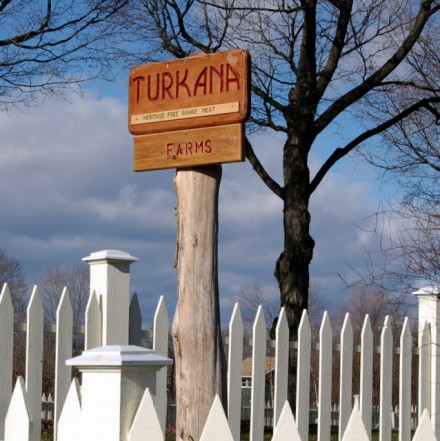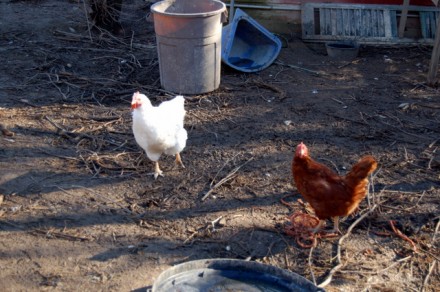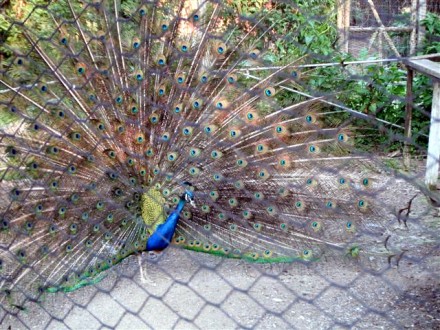AgriCulture bloggers Peter Davies and Mark Scherzer are the owners of Turkana Farms in Germantown, NY. This week Mark writes.

This is the season when we all make resolutions for improvement in the new year. While I consider myself a person of reason, not trapped in age old superstitions, I am not immune to this practice. Until recently, I never questioned my selection of resolutions, which always seemed obvious and inevitable, but lately I have had lots of cause to do so. I’ve accepted that I am an inveterate workaholic, yet so often my resolutions have been to improve my life by working even harder in the new year. Not a change of course, but rather more of the same. I think the instinct for more of the same must be imprinted very deep in our animal selves. I’ve certainly gotten that picture from our constant interaction with other creatures whose behavior has the capacity to drive us crazy. Take our rogue commuter chicken, for example. Chickens generally act as a chaotic flock, not as individuals. Although not as regimented as geese, they will usually all move as a flock to the same general area at the same time and engage in the same activities. This is not just when they're pursuing food, but also when they are laying eggs. If one chicken lays an egg in a box, others will generally follow suit, sometimes doubling up in the same box simultaneously. Indeed, you can buy a stone egg to place in a box in order to encourage other chickens to lay there. When they brood they are often on a clutch of eggs produced collectively by the flock.

Why is it that our commuter chicken, a flock animal, feels compelled to leave the coop every morning and go lay an egg somewhere else, only to then hang out at the end of the day near the door to the coop waiting to be let back in? What accounts for her deviance? Last week I think I finally got it somewhat figured out. We knew at some point in the late summer she was laying her eggs in a nice soft nest of coiled hay twine in the garage. When we cleaned that area of the garage up, she moved on to nesting points unknown. Unknown, that is, until about a month ago when Peter, while raking out the herb garden, found a cache of her eggs in a leaf pile right up against our house. The removal of the leaves once again deprived her of a safe place for her clutch of eggs, and she moved on again. To where? We couldn't figure it out until by chance last week, as I was feeding the peafowl, I heard clucking of unknown provenance from what seemed like inside the rosebush next to the peacock pen's door. Peter protects the rose bushes in that area, which are exposed to brutal northwest winds, by creating conical burlap tepees around them, and loading the interior of the structure with raked up maple leaves as insulation. Protected inside the burlap cover, nestled in the bed of leaves, there sure enough was another egg cache. Having discovered her secret, we can now check daily there for eggs so that her production does not go to waste. More important, with the accumulated evidence of three successive egg laying environments, I feel we can now say with some assurance that what is imperative to this particular chicken as a place for laying eggs is something about the surface she’s laying on. Not a wooden nesting box with straw, but a reasonably invisible nest of soft, pliable substances like leaves and twine. We may now try to replicated this set-up for her inside the hen house, and hopefully keep her “commuting” to a minimum in the more dangerous winter months. (Peter thinks her deviance is deeper than that. He believes she has become an inner-directed chicken and does what she pleases. She is not, in his view looking for a particular kind of nesting material. She is the Greta Garbo of chickens, and simply "vants to be alone.")

But I think Peter is wrong. I’ve recently been reading a book, The Chemistry Between Us, that in a highly entertaining recounting of scientific research identifies the biological and chemical foundations of sexual attraction and love. It reports on experiments in which male rats were essentially led to develop sexual leather fetishes by imprinting an association between sexual activity and the wearing of little leather jackets. Once that association was developed, these rats were unresponsive to the usual signals given off by estrous females unless they had their jackets on. I have to imagine that our commuter chicken must have, by chance, found great pleasure in laying eggs on some soft nest early in her career, and now feels absolutely compelled to find that sort of surface when the time to lay that almost daily egg comes on.

Humans, too, seem to have a proclivity for always repeating more of the same. You may find it bizarre in the case of some sexual fetishes, and somewhat less bizarre when you consider that people often fall in love with partners who resemble their previous partners, as they’ve “got a thing” for a certain characteristic or other. But this repetition of learned behavior, the idea that doing more of the same can actually make things better, pervades our public life and economy, too. This was all too evident recently when the head of the National Rifle Association suggested that the only way to protect schoolchildren like those slain at Sandy Hook Elementary from gun violence would be to place armed police guards in every school. If the problem is guns in school, the answer becomes more guns. When the horrific trap and ambush of volunteer firefighters in Webster, New York, occurred shortly thereafter, Peter wondered whether the NRA would also suggest that all fire-fighting crews have armed guards riding shotgun as well. Looking to more guns as the antidote to guns is, of course, why we have arms races on a national scale, rather than looking to disarmament or other perhaps more creative solutions. We’ve seen similar thinking for a long time in other human endeavors. Take transportation. If roads in a city are too clogged, the solution is often to build a new road, that is, a ring road to detour traffic around it. When, inevitably, the new road attracts new traffic and itself becomes clogged, yet another ring road is built at a further distance from the center. Many of the world’s great cities are now bounded by concentric circles of ring roads. How many ring road failures does it take, one wonders, for us to fundamentally rethink our dependence on individual automobile transport in highly populated areas, and look to more rational means of getting about? How do we shift from thinking that the answer to problems with roads is more roads? And let’s consider agriculture, where we have achieved the dubious victory of making massive amounts of animal protein available for human consumption by creating industrialized concentrated animal feeding operations that epitomize the principal of “more of the same.” These operations crowd animals together and stuff them with foods and growth-inducing agents that their body metabolisms are not structured to handle well. The result is unnaturally fast growth of the animal, satisfying the profit motive, but these conditions also produce changes in body chemistry, create breeding grounds for pathogens,and promote illnesses. And rather than questioning whether we should be putting animals on these diets and keeping them in such environments in the first place, the industry’s solution to those illnesses and pathogens has been to add more questionable inputs and procedures on top of the ones that are already being used. Thus we have routine administration of antibiotics and irradiation of meats, regardless of their potentially dangerous side effects. When our answer to gun violence is creating more opportunities to shoot, our answer to road congestion is creating more opportunities to drive, and our answer to inappropriate animal feed is administration of inappropriate drugs, then I would argue that we may be suffering from a bad case of “more of the same.” When we are resolving this New Year to do things better next year, maybe we should consider the possibility that doing more of what we already have been doing is not necessarily an improvement. We should be less enslaved to what we're accustomed to doing than the commuter chicken. Think hard before you make that resolution.









